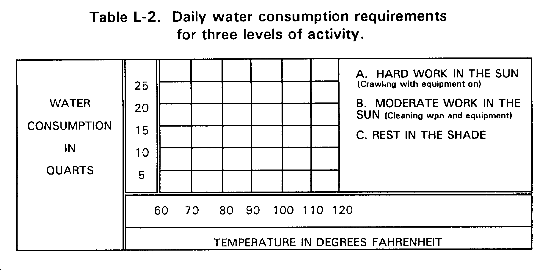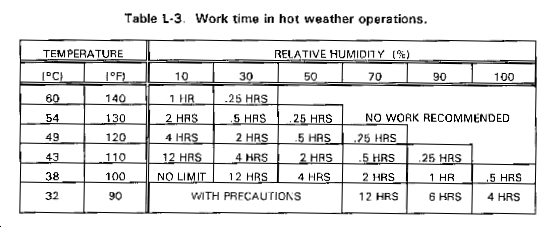FM 34-81-1: Battlefield Weather Effects
APPENDIX L
WEATHER EFFECTS ON PERSONNEL
Weather has a great impact on the soldier, particularly extreme temperatures. It may have a more immediate impact on the human body than on systems and equipment. Each soldier is unique because of differences in physical conditioning or a higher tolerance to hot and cold temperatures.
Regardless of physical differences, temperature, surface wind speeds, and relative humidity affect everyone to a degree. This is particularly true for physical activity, personal protection, and water consumption.
The products and information you develop as part of this appendix should be included in all weather effects briefings prepared for the commander and staff.
COLD WEATHER ENVIRONMENT
A soldier's greatest concern in extreme cold is survival. Soldiers spend much of their time trying to keep warm and protecting exposed skin from frostbite. Cold temperatures and wind speed create a windchill factor which has a definite effect on the soldier.
Your weather forecast includes temperatures in degrees Fahrenheit and wind speed in nautical miles-per-hour (knots). Table L-1 lets you use temperatures in Fahrenheit and wind speed either in statute miles or knots to determine windchill values and effects.
Extreme cold results in an increase of water consumption by soldiers. This is due to working outdoors in heavy clothing and the dry air that usually accompanies cold weather.
Wind and cold effects on military free-fall parachutists must be taken into account when planning these kinds of operations.
AMBIENT AIR
Ambient air temperatures at high altitudes can be calculated using the standard temperature lapse rate of 2° C (3° F) for every thousand feet increase AGL. For example, a military free fall jumpmaster spotting an aircraft at 25,000 feet AGL where the ground temperature is 50° F would be jumping into an air temperature of -25° F (calculated at 50 °F-( 25 x 3° F)).
WINDCHILL FACTOR
The windchill caused by the speed of the aircraft (130 kn) increases the problems for the jumpmaster. Parachutists in free fall attain a terminal velocity of 120 mph. Parachutists conducting HAHO operations can be under canopy for as long as 35 to 40 minutes, and be exposed to bone-numbing cold temperatures as they descend. To succeed, they must be equipped to withstand these harsh conditions.
HOT WEATHER ENVIRONMENT
In hot weather the important factors are temperature and relative humidity. The Soldiers' primary concerns are physical exhaustion and dehydration. You must consider both because a common work task will take longer and additional water may have to be transported during hot weather. The following hot weather concerns play a role in the employment of soldiers.
WATER ADEQUACY. Water supplies and the enforcement of its intake before, during and after physical activity is critical for survival.
WORKLOAD CORRELATION. Workload or training activities must be adapted to environmental heat stress conditions.
REST PERIODS. Adequate break time must be provided for physically active personnel in a hot environment.
CHILLED DRINKING WATER. Soldiers will often reject warm drinking water even when they are significantly dehydrated.
ADJUST PHYSICAL ACTIVITY. Soldiers' introduction to physical exertion in a hot climate upon arriving from a temperate one should be as gradual as circumstances allow. They will need 1 to 2 weeks' time to physiologically adjust to the new climate. Lighten physical activity during this period to ensure optimum performance.
SALT. Sodium intake must be maintained in hot weather. Two good meals a day normally provide enough salt for most soldiers.
HUMIDITY. This can be tricky. A low WBGT index (for example, in the morning) may not be a totally safe indicator if the humidity is high. High humidity retards cooling by evaporation of sweat, and decreases the urge to drink sufficient water.
WATER SPRAY. A water mist will cool a person off. But it should never be substituted for adequate consumption of water before, during, and after strenuous activities in the heat.
Tables are provided that use a temperature measurement (or temperature forecast) and a relative humidity calculation. The SWO can routinely provide you with temperature and relative humidity forecasts. If you need air temperature values measured at your particular location, use the thermometer included in the FALOP BWK.
HOT WEATHER WATER REQUIREMENTS
Table L-2 shows the water needs (in quarts per day) for soldiers at 3 activity levels over an 8-hour work period. To determine soldiers' average water needs, you have to know the air temperature and decide the level of activity the troops will be doing. For example, if a soldier is doing 8 hours of hard work in the sun (curve C) when the average temperature for the day is 100° F, his water requirements for the day will be around 15 quarts.
This amount of water can be converted into extra weight the soldier must carry. One quart is equal to 2 pounds so the 15 quarts of water would weigh 30 pounds.
HOT WEATHER WORK TIME LIMITS
Table L-3 shows the time limits during which work can be safely performed in hot weather. In computing the time limits, both air temperature and relative humidity are considered. The values are based on a sitting soldier in BDUs doing light work.
The table gives an estimate of the length of time continuous work should be performed. For moderate work a technical manual on the PATRIOT missile system recommends that you sue on-half the values contained in the table. You should not consider these tables as absolute limits--especially since light, moderate, or heavy work are difficult to quantify. Table L-4 indicates work time in hot weather based on the WBGT index.
|
NEWSLETTER
|
| Join the GlobalSecurity.org mailing list |
|
|
|





